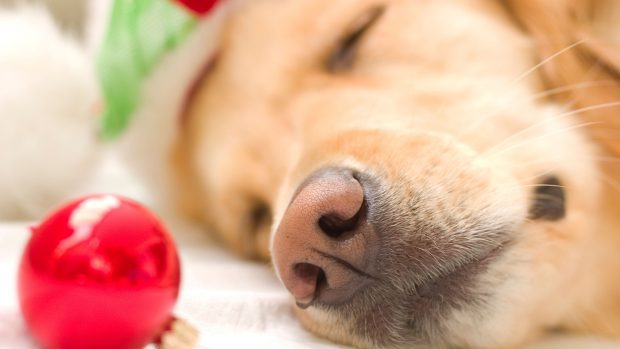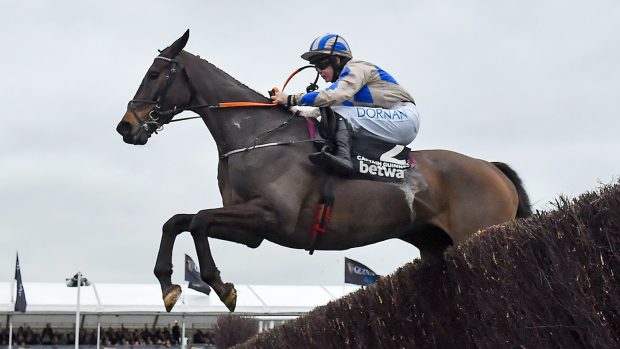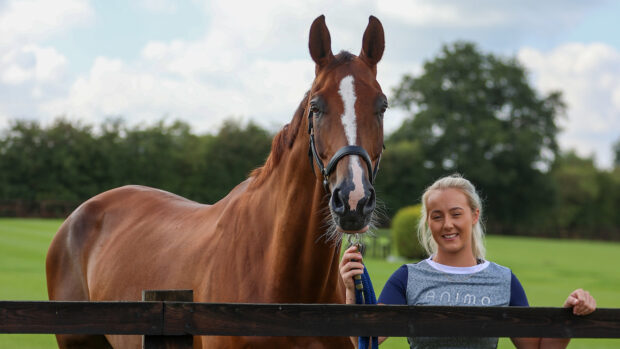Aside from the obvious — being a four-legged animal — dogs and horses are the same in many ways. From the way they respond to certain situations to how they socialise, dogs and horses share many similarities, and you can certainly use this to your advantage when it comes to training and bonding with your animal.
Here are a few ways that dogs and horses are similar, and how you can make this work for you.
1. Physical traits and origin
Beginning with the history, both dogs and horses, alongside lions, cats, cattle and pigs, all share a common ancestor. They are all classified as the same type of animal, a mammal. In sum this means they give birth to live young and milk produced by the mother’s mammary glands is used to feed the young. All mammals are warm-blooded, have fur or hair and they arguably have a more complex brain than other animals.
Horses and dogs both have a natural instinct to herd. Dogs have a drive to herd flocks, but also an innate desire to chase things. Horses also have an instinct to herd, and it’s commonplace for humans to ride horses while herding livestock.
Both dogs and horses have been useful animals throughout history and they continue to be great working partners when trained correctly and once they understand what is being asked of them.
Most dogs and horses are also very social animals and they thrive off either living with others or from regular interaction with those from the same species. Most horses enjoy regular grooming sessions if given the opportunity, while dogs are likely happy to play and interact with others.
2. Domestication
In modern times, both dogs and horses have been domesticated, arguably being the two most popular species of animal that are bred and developed by humans for specific purposes. Dogs are most commonly bred as pets but they are also bred for agility, hunting, racing or military and police work, and other more niche activities such as sledge pulling and showing. Initially, a lot of dog breeds were bred for certain jobs which have either been phased out, banned or continue to this day.
For example, the greyhound, originally bred in Europe though it’s believed they may originate from Egypt, is the fastest of all the dogs and is known as a racing breed due to their agility, sleek bodies and short digestive tracts. The bloodhound was originally bred in Belgium in the eighth century and they are still famed and used widely for their unmatched sense of smell and abilities to pick up scents. The Saint Bernard, with its size, thick fur and stature, was bred in the Swiss Alps where they were used as rescue dogs in the mountains. The Border Collie is one of the most intelligent dog breeds with exceptional stamina and is still used by farmers worldwide as a sheep-herding dog.
Similarly, many breeds of horses and ponies had original jobs that they were intended for. Many of the British native breeds were bred to work the land in their specific areas of origin, where some herds still reside today. For example, the Highland pony was once a work pony in the Scottish mainland and islands, and they are still used, though less commonly, on the hills of Scotland to carry stags. The ever-popular thoroughbred is still the breed of horse associated with racing. Nearly all of today’s racehorses can be traced back to one of three Arabian stallions imported into England during the 17th and 18th Centuries by those who had ambitions of breeding faster horses. These horses were crossed with Britain’s heavier horses to produce offspring considered to be the first crop of thoroughbreds.
Over the years, many breeds of dogs and horses have been refined and altered to suit the needs and wants of humans, whether that be to make them more aesthetically pleasing or to give them added athleticism, strength, size or stamina.
In modern times, both dogs and horses are used in law enforcement. Horses are part of the mounted police force, while dogs are trained to assist police and other law enforcement officers. Both dogs and horses are also used in some forms of therapy. Both animals are good at reading people and picking up on energies, emotions or moods. People who have suffered trauma may find it helpful to see how a horse responds to a situation, too, by how it uses its instincts and has natural boundaries.
How can we use dog and horse similarities in training?
Dogs and horses are the two most common species of animal seen in trained positions. Both are highly intelligent, trainable and workable animals in their own rights. Like humans, though, individuals will have more capacity and talent for training, and some breeds are likely to thrive in certain roles over others.
3. Responding to pressure
Dogs and horses have a similar reactions to a sustained amount of tension or pressure. What we know about this can help us work with horses and dogs on leads.
If you push a horse to move back it will instinctively lean in against the pressure, and if you pull a horse firmly on a lead rope, lunge line or similar then it will lean back against the tension, creating a sort of tug of war situation. In both situations, the human will always lose if the horse is using all of its strength, simply due to the size and weight difference. Tension as such can instil panic in a horse as they try to get rid of the feeling in the only way they know how, by pushing on or pulling back. Creating a push and release system is how to get a horse to move backwards, for example if he has stood on your foot. Similarly, a jerk and release system is more beneficial if the horse is pulling back on a rope and won’t lead, as opposed to a constant pull to try to make it move forward or follow. The same rules apply to a dog who is being walked on a lead, as dogs will also react instinctively to pressure.
An example of this in action is the need to maintain an elastic contact between the rider’s hand and the bit, while simultaneously using the leg on the horse and pushing in the saddle to create a give and take effect. If you ride with a constant tension down the reins, the horse will likely resist this by pulling down harder on the bit and becoming what riders know as strong. This situation can be applied to the dog owner who is pulling constantly on the lead without any give when their dog is excitable. The dog will respond by pulling down on the lead, creating more pressure.
4. Reacting to situations
As people become more experienced with either dogs or horses, they become better at predicting certain situations before they have even happened and they learn what to expect ahead of time. Experienced handlers or trainers use cues from animals to pick up on this, in effect getting a jump start to prevent unwanted behaviours or reactions, which can be dangerous in some instances. Getting ahead in such a way is helpful, especially when working with young animals, as you can help modify behaviours before they become habits.
An example is a horse spooking at a flapping sign while on hack, or a dog displaying aggression to other dogs during a walk. We can attempt to prevent a horse from spooking by being aware of the potential trigger and of cues given by the horse, such as an abrupt lift of the head and a prick of the ears. Then, we can firmly but calmly guide the horse away from the object by directing their attention back onto the road ahead. This not only helps avoid an unwanted situation and reaction, but it also reinforces the horse’s trust in the rider or handler.
The reactive dog also needs a handler who is going to spot the potential sign of trouble before it’s even happened during the intention phase. A dog might also perk up the head and show intense interest in what’s ahead, perhaps another dog on a lead. Ensuring you spot in the intention can go a long way in preventing the dog reacting in a potentially dangerous way. As with the horse, you can predict the situation, move the dog away, keep him calm and do your best to de-escalate.
5. Consistency and leadership
Both dogs and horses require consistency to learn new tricks, habits or training aids. We should always be patient, calm and clear when teaching an animal something new. Consistency, however, does mean that sometimes you need to follow through with your intentions, no matter how long it will take, until the action has been done. For example, a horse might not want to load into a lorry or a trailer. If we let the horse not go into the box when it refuses then the horse will experience a rush of relief, akin to a reward, for this behaviour. At the stage of refusal, it’s key that we follow through and ensure the outcome is what we originally intended, or as close to as we can ensure safely. This does not mean using force or violence, but being as firm as necessary to get the job done. Once the horse has gone into the trailer or lorry, we can reward with plenty of reinforcement. It is likely that next time you won’t have such a reaction from the horse as trust is built. Dogs also need to know who is in charge of the situation.
You need to ensure that what you’ve asked is done at the time, then they learn and associate behaviour such as throwing their weight around and making outbursts as how they get out of things they don’t want to do. This leads onto the general idea that both dogs and horses require a leader who acts with confidence and is in control. This ensures you are taken seriously and respected by the animal but more than anything, it’s reassuring for them and it helps them feel calm. Spoiling or mollycoddling your horse or dog does not help them become less scared but it reinforces their belief that something is in fact scary or something to be feared and avoided.
6. The human bond
Both dogs and horses are capable of developing extremely strong bonds with humans, likely with one person they deem to be their caregiver or ‘main’ person. By spending a lot of time together, both in training and in down time, we begin to predict each other’s intentions; it’s not just us who can spot the moves of our animals, they can equally predict ours. The harmony seen between some riders and their horses, or handlers and their dogs, is magical, and some of the work these people get out of the animals is something obviously only they will be able to achieve. Building a great relationship with your dog or horse comes down to trust, respect and understanding.
7. Communication
Horses and dogs use body language and gestures to communicate and they generally do not vocalise themselves, aside from when they are either reacting to something in either a positive or a negative way, or they are alerting to danger. They can also learn to respond to voice commands but it’s our job as trainers and owners to be as clear and concise as possible. They can also pick up on the tone of our voices, too. Over-talking to our animals, especially dogs, is one of the main reasons they develop selective hearing. Adding gestural cues to commands helps animals understand what we’re asking.
You may also be interested to read…

Did you know: a hound is a dog, but not all dogs are hounds

Signs, causes and coping strategies for reactivity in dogs – explained by an expert

How to master recall

Subscribe to Horse & Hound magazine today – and enjoy unlimited website access all year round
Horse & Hound magazine, out every Thursday, is packed with all the latest news and reports, as well as interviews, specials, nostalgia, vet and training advice. Find how you can enjoy the magazine delivered to your door every week, plus options to upgrade your subscription to access our online service that brings you breaking news and reports as well as other benefits.





